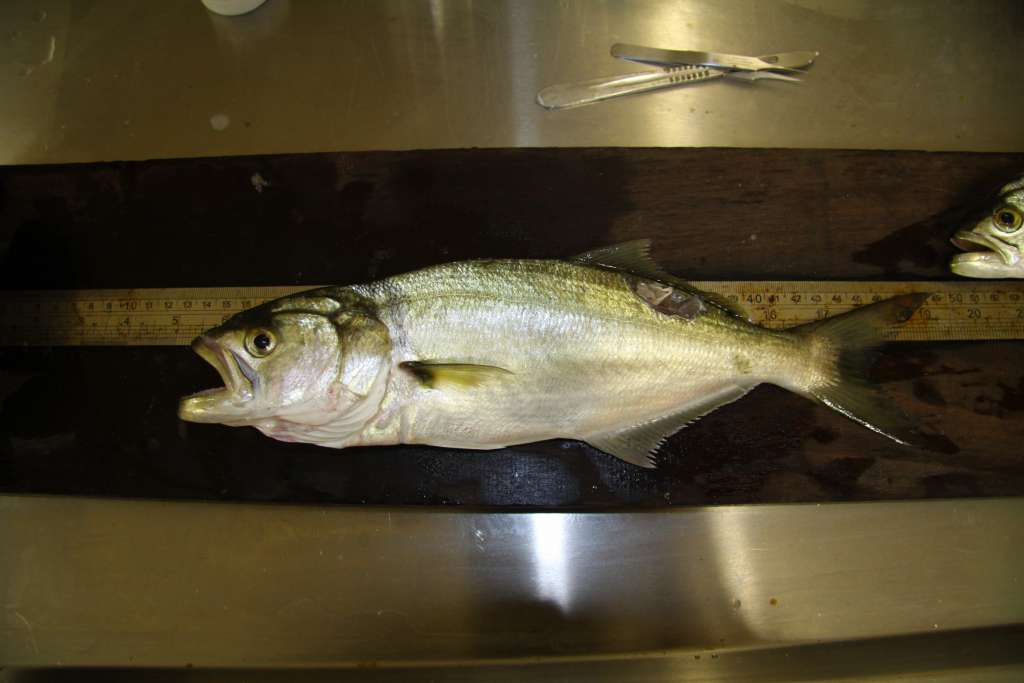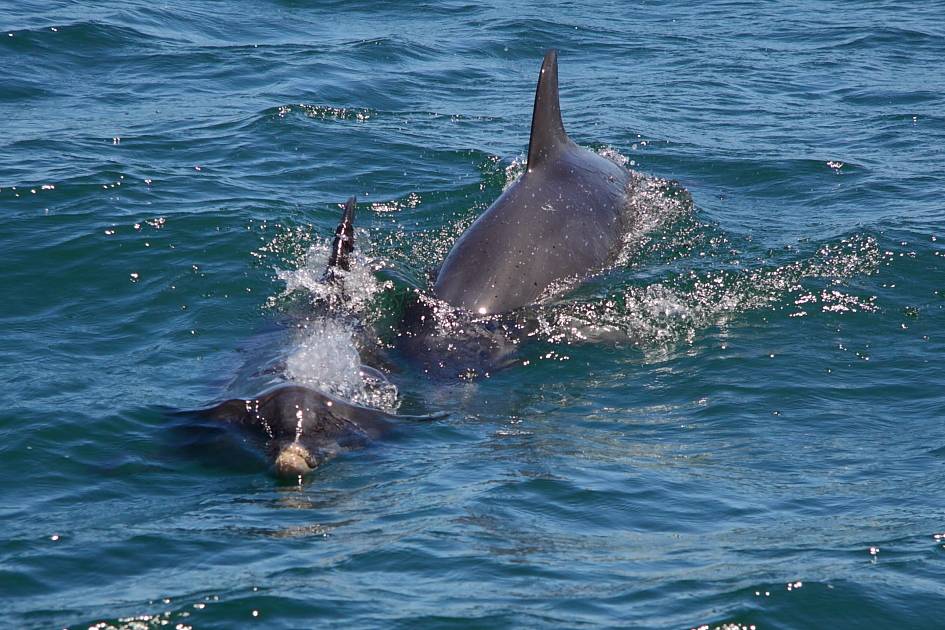Bottlenose dolphins can be quite selective in their foraging preferring the most calorie-rich prey when hunting, according to a new Australian research paper which could help tailor conservation efforts to protect these beautiful animals.
In a paper published in November last year in Global Ecology and Conservation1, researchers led by scientists at Murdoch University looked at populations of bottlenose dolphins off the Western Australian coast and found that different groups preferred eating different fish depending on whether they hung around near shore or preferred to move to the deeper ocean and back.
Lead author Shannon McCluskey of the College of Science, Health, Education and Engineering at Murdoch University talked to Lab Down Under about how forming a more complete understanding of what dolphins ate would help tailor future conservation and management projects that targeted the marine ecosystem as a whole.
“It’s a really basic biological need to have, not just foods, but the right kinds of foods, so the quality as well as quantity. And so from a management perspective, if you don’t know what that means or what your priority is for managing — in this case fisheries, recreational and commercial fisheries, land development, contaminant loads, anything that might effect those prey species — you can prioritise where your money and your effort goes,” she said.
Forming a bigger picture on dolphin diet
In order to probe the foraging behaviour of bottlenose dolphins, McCluskey and her team conducted two types of tests: examining the stomach contents of deceased dolphins which had been collected from beaches near the WA city of Bunbury, and stable isotope testing which examined the chemical makeup of skin tissue collected from live dolphins using small darts to determine what that animal had eaten.
“Stable isotopes give you a broader and longer — a stepping back, big picture view — and the stomach contents give you the snapshot, in-the-moment view that’s much more specific. So together, they’re like using two pieces of the puzzle to sort out the picture instead of just one,” McCluskey said.
Stomach content analysis is literally looking through an animal’s stomach for the hard parts of prey it has consumed. The benefit of this approach is seeing what’s actually ingested within the stomach of the animal. This is one of the only ways to see what marine animals actually eat because they often consume their prey underneath the surface away from human eyes.
Stomach content analysis allows scientists to spot the individual species eaten by an animal, and also the length and age of any prey consumed. However, the technique has a short time-frame and is limited to what that animal ingested in the past several days or weeks, McCluskey said.

Image: Fish found in dolphin stomach. Picture by Shannon McCluskey. Used with permission.
Stable isotopes, on the other hand, offer insights on a much larger timescale of weeks, months or even years. In this study, McCluskey examined the carbon and nitrogen isotopes found in the dolphin’s tissue which arrived there from the food it consumed. The signature of these isotopes can tell scientists where a predator is physically hunting its prey and where the prey actually sits in the food chain.
“You are what you eat. So when we ingest something, our body breaks it down into its fundamental bits. And when we’re looking at isotopes, and looking at really the most fundamental bits of those pieces, our body assimilates it. We literally assimilate those bits into our tissues, and all of our tissues, our skin, our blubber or fat, muscle, hair and bone.”
Isotopes are variants of chemical elements like carbon, nitrogen and oxygen that contain different numbers of neutrons. For instance, a carbon atom will always contain six protons but may vary in the number of neutrons. There are 15 known isotopes of carbon for instance, the most stable being those containing either six or seven neutrons.
Prey with more ‘bang for its buck’
The study found that dolphins who constantly hang out near the Bunbury coast consume different prey than those who alternate between the coast and deeper waters. The population of bottlenose dolphins in the region fluctuates between around 180 in the summer to less than 75 in the winter. Those who remain near the coast all year round are typically mothers and their offspring.
“There are two groups of dolphins that come together, they share habitat, they intermingle, they certainly breed together but they’re occupying different ecological niches,” McCluskey said.
The in-shore dolphins that remain close to the land year-round consume prey from shallow waters like estuaries while the coastal dolphins focus on deeper water offshore. This means both populations of dolphin should be considered as separate, requiring different strategies for conservation and management prioritising the specific fish that they eat, despite living in the same region.
“We saw specialisation in their diet. They were not just eating things because they were there. They were not eating things in proportion to what was available in the environment. So there’s some specialisation which again is a reflection too on quality of prey. They’re really selectively foraging on prey that is more calorically beneficial and more bang for your buck,” she told Lab Down Under.
“These dolphins really do seem to be selecting for high quality prey. There’s a lot of prey out there that’s kind of like junk food that they could eat lots of but it’s not going to do them much good in the long run.”
Video: Lab Down Under’s interview with Shannon McCluskey on her dolphin research
One surprising finding was how small the prey actually were, McCluskey said. A lot of fish found in the stomachs were little gobies that were a few inches long. While these fish were calorically high in value, the dolphins had to eat a lot of them.
Usually this type of “partitioning” among a species is a way to decrease competition among groups of animals, with each group hunting different types of prey while sharing the same habitat. Since dolphins were long-lived, a lot of their habits were learned from their mothers in a trend which could lead to specialised foraging strategies as well, McCluskey said.
More studies needed to boost conservation
Limitations of the study are the sample sizes caused by the fact that researchers had to rely on deceased bottlenose dolphins washing ashore so they could examine the stomach contents. There is also a need for further research in this area, McCluskey said.
“We need more diet studies just of predators in general to shed light on each other. We have very limited knowledge of the prey base in this area. So to expand on this research would be to go out and take more samples of prey, do more stable isotopes of prey, hopefully get more stomachs, and just increase the numbers.”
Stomach content analysis also contains a bias towards prey with hard segments such as bones and cartilage. Softer prey like octopi, squid and jellyfish are much harder to detect due to the stomach’s digestive juices and so are more difficult to research in these types of foraging behaviour studies.
McCluskey said she hoped the research would be used to further tailor conservation strategies to include protecting the specific types of prey that bottlenose dolphins ate and focus on those preferred by these mammals.
More information on the research done by McCluskey and the team at Murdoch can be found on the Aquatic Megafauna Research Unit’s website and the Blue Muse Facebook page.
Author’s note: If you enjoyed this article, you can follow Lab Down Under on Facebook and LinkedIn or support me on Patreon. I also have my own personal Twitter account where I’ll be sharing my latest stories and any other items of interest. Finally, you can subscribe here to get my blogs in your inbox.
1 McCluskey S, Sprogis K, London J, Bejder L, Loneragan N. Foraging preferences of an apex marine predator revealed through stomach content and stable isotope analyses. Global Ecology and Conservation, 25 (2021) e01396.
Featured image: Bottlenose dolphins off Bunbury coast. Picture by Shannon McCluskey. Used with permission.
